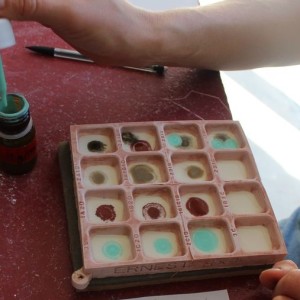Ernest 4×4 en anglais approximatif
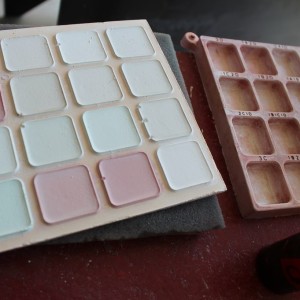
The Ernest 4×4 model is suitable for all searches, progressions and colour charts. It offers fairly visible tests in size, but the progression is a little less fine than with the 5×5.
Video demonstration here
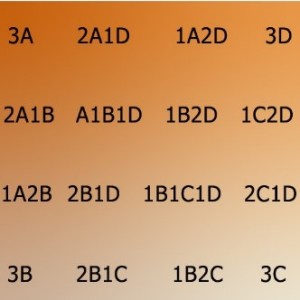
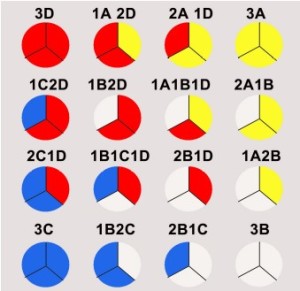
Progression
I recommend for this model to make a basic recipe of 25 g which will be diluted with 35 g of water ( 1.4 times the amount of Dry Matter ) Then we divide this 60 g of liquid glaze into 4 equal parts or 15 g per bucket. In doing so, we have 6.25 g per bucket of MS . As we put 1.5 ml of mixture per box, we will have the same amount of MS per box in the occurrence 0.84g. As the squares are 9 cm², one will have about a thickness of glaze corresponding to about 10 g to dm² which is an average thickness for an enamel.
The additions we make in A, C and D will be calculated in % of the dry matter. For example, in C, we will add 20 % of silica. 20% of 6.25g =1.25 g of silica put in the C+ bucket. In A we will add 10% of kaolin ,10% of 6.25g = 0.625 g to put in A+. In the bucket D+ will be put 1.25 silica and 0.625 kaolin. Here, the additions are important, so we will add in C water to maintain our ratio of MS to water, the amount of water added is 1.25×1.4 or 1.75 ml of water in C, this addition is done to the syringe. Same for A with 0.87 ml and D 1.75+0.87= 2.62 ml. This may seem disturbing at first. But if we always make the same kind of progression, it becomes easy.
Once the 4 buckets A, B, C and D are prepared, we follow the instructions for use (download the instructions for use) and must accompany you to the workshop. If you are afraid of being wrong in the distribution in Ernest’s boxes, you will put food colours in A, C and D following the recommended colours.
Color chart
For this Ernest 4×4 large model, if we dilute our MS to 1.4, we will have, by putting 1.5ml per box, 0.84g of MS per box. If, on the other hand, an oxide diluted to 1.7g per 10 ml is added to a drip. The addition of a drop of our oxide in a cell will correspond to an addition of 1% of this oxide in the enamel contained in the cell. This 1% is obviously calculated in relation to dry matter. I have given you some intermediate calculations. This dropper method is valid for additions of dye oxides, pigments or materials that may be in small quantities in enamel (titanium, tin, zircon, etc.). for example, if we dilute cobalt to 0.34 g for 10 ml in our dropper count we will have 0.2% per drop. In the drop count we can put a “knife tip” of bentonite to limit the “filling”.
To make our color charts, I advise to always use the same Ernest and the same dilution of the basic preparation We prepare in droppers with the desired dilutions that we keep from one test session to another in a closed container to avoid evaporation. Note on the drop count dilution and for example Cobalt 0.2% / drop or Manganese 1% per drop etc
In practice we start by making this type of notation on the back of the tile that we put next to Ernest. We put 1.5 ml per box of Ernest of our base and we put our drops as indicated on the tile. There is no inversion of direction.
You can download the instructions here. You can laminate it and use it as a table set..
set-de-table
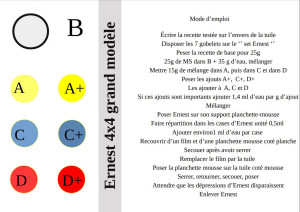
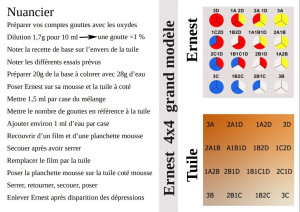
La calculette Ernest est téléchargeable ici en version ods Calculette_Ernest2022ods
ou en version excel Calculette_Ernest2021

